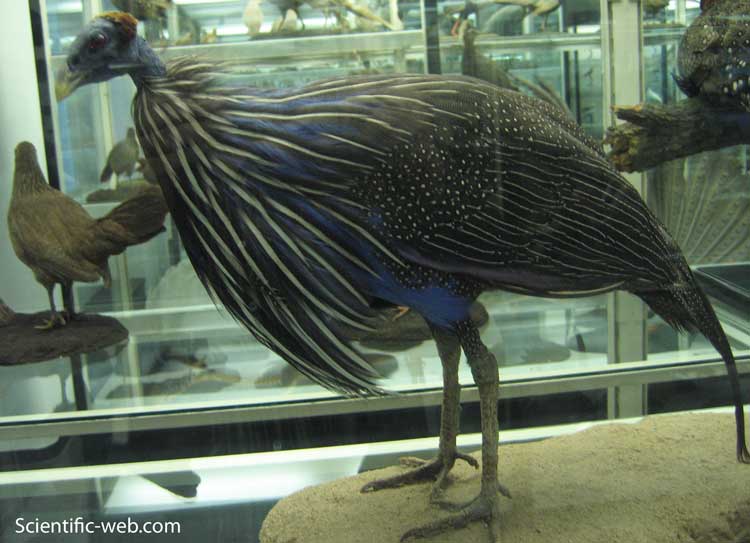
Acryllium vulturinum, Photo: Michael Lahanas
Superregnum: Eukaryota
Regnum: Animalia
Subregnum: Eumetazoa
Cladus: Bilateria
Cladus: Nephrozoa
Superphylum: Deuterostomia
Phylum: Chordata
Cladus: Craniata
Subphylum: Vertebrata
Infraphylum: Gnathostomata
Superclassis: Tetrapoda
Cladus: Reptiliomorpha
Cladus: Amniota
Classis: Reptilia
Cladus: Eureptilia
Cladus: Romeriida
Subclassis: Diapsida
Cladus: Sauria
Infraclassis: Archosauromorpha
Cladus: Crurotarsi
Divisio: Archosauria
Subsectio: Ornithodira
Subtaxon: Dinosauromorpha
Cladus: Dinosauria
Ordo: Saurischia
Cladus: Eusaurischia
Cladus: Theropoda
Cladus: Neotheropoda
Infraclassis: Aves
Cladus: Euavialae
Cladus: Avebrevicauda
Cladus: Pygostylia
Cladus: Ornithothoraces
Cladus: Euornithes
Cladus: Ornithuromorpha
Cladus: Ornithurae
Cladus: Carinatae
Parvclassis: Neornithes
Cohors: Neognathae
Cladus: Galloanseres
Ordo: Galliformes
Familia: Numididae
Genus: Acryllium
Species: Acryllium vulturinum
Name
Acryllium vulturinum (Hardwicke, 1834)
References
PZS Pt2 no.18 p.52
Vernacular names
Deutsch: Geierperlhuhn
English: Vulturine Guineafowl
magyar: Keselyűfejű gyöngytyúk
lietuvių: Grifinė patarška
Nederlands: Gierparelhoen
svenska: Gampärlhöna
ไทย: ไก่ต๊อกอีแร้ง
Türkçe: Akbaba beçtavuğu
The vulturine guineafowl (Acryllium vulturinum) is the largest extant species of guineafowl. Systematically, it is only distantly related to other guineafowl genera. Its closest living relative, the white breasted guineafowl, Agelastes meleagrides inhabit primary forests in Central Africa. It is a member of the bird family Numididae, and is the only member of the genus Acryllium. It is a resident breeder in northeast Africa, from southern Ethiopia through Kenya and just into northern Tanzania.
Description
Upper body
At Tsavo East National Park, Kenya
The vulturine guineafowl is a large (61–71 centimetres (24–28 in)) bird with a round body and small head. It has a longer wings, neck, legs and tail than other guineafowl. The adult has a bare blue face and black neck, and although all other guineafowl have unfeathered heads, this species looks particularly like a vulture because of the long bare neck and head.
The slim neck projects from a cape of long, glossy, blue and white hackles. The breast is cobalt blue, and the rest of the body plumage is black, finely spangled with white. The wings are short and rounded, and the tail is longer than others in the family Numididae.
The sexes are similar, although the female is usually slightly smaller than the male and with smaller tarsal spurs. Young birds are mainly grey-brown, with a duller blue breast and short hackles.
Behaviour
The vulturine guineafowl is a gregarious species, forming flocks outside the breeding season typically of about 25 birds. This species' food is seeds and small invertebrates. This guineafowl is terrestrial and will run rather than fly when alarmed. Despite the open habitat, it tends to keep to cover, and roosts in trees. It makes loud chink-chink-chink-chink-chink calls.
It breeds in dry and open habitats with scattered bushes and trees, such as savannah or grassland. It usually lays 4–8 cream-coloured eggs in a well-hidden grass-lined scrape.
References
BirdLife International (2016). "Acryllium vulturinum". IUCN Red List of Threatened Species. 2016: e.T22679572A92819650. doi:10.2305/IUCN.UK.2016-3.RLTS.T22679572A92819650.en. Retrieved 19 November 2021.
Further reading
Pheasants, Partridges and Grouse by Madge and McGowan, ISBN 0-7136-3966-0
Retrieved from "http://en.wikipedia.org/"
All text is available under the terms of the GNU Free Documentation License

